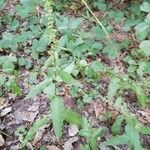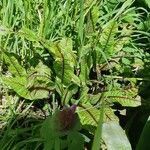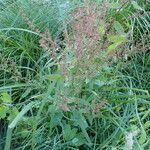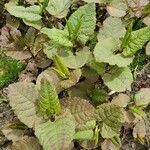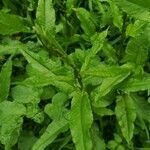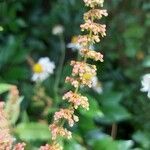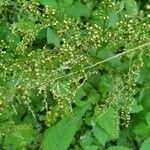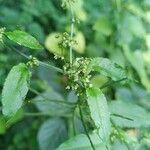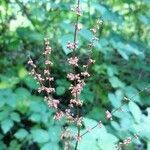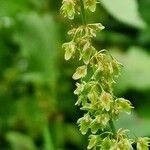Plants perennial, normally gla-brous, rarely very indistinctly papillose on veins of leaf blades abaxially, with fusiform, vertical rootstock. Stems erect, branched in distal 3, sometimes branched almost from base or with few flowering stems from rootstock, 30-70(-90) cm. Leaves: ocrea deciduous to partially persistent at maturity; blade oblong-lanceolate, obovate-lanceolate, or lanceolate, normally (5-)10-30 × 2.5-6 cm, base rounded, truncate, or subcordate, rarely cuneate, margins entire to obscurely repand, flat to slightly undulate, apex acute or subacute, occasionally attenuate. Inflorescences terminal, occupying distal 2/ 3 of stem, lax, interrupted, broadly paniculate, branches simple or nearly so; panicle leafless or leafy only near base. Pedicels articulated in proximal 1/ 3 or rarely near middle, filiform, (2-)4-6(-8) mm, normally distinctly longer than inner tepals, articulation distinctly swollen. Flowers 10-20 in lax, remote whorls; inner tepals oblong-lanceolate, oblong, or lingulate, 2-3 × 0.8-1.3(-1.8) mm, ca. 2 times as long as wide, base cuneate or subtruncate, margins entire, apex obtuse; tubercle 1 (occasionally 3, then 1 much larger, almost as wide as inner tepals). Achenes usually dark reddish brown to almost black, 1.25-1.5(-1.8) × 1-1.3 mm. 2n = 20.
More
A clumping herb. It grows 50-100 cm high and spreads 30-90 cm wide. The stems are dark. The leaves are lance shaped. They are 15 cm long. The veins are red. The flowers are small and green on long stalks.
With the valves 3–4 mm, only one bearing a subglobose grain, is probably only a waif with us.
